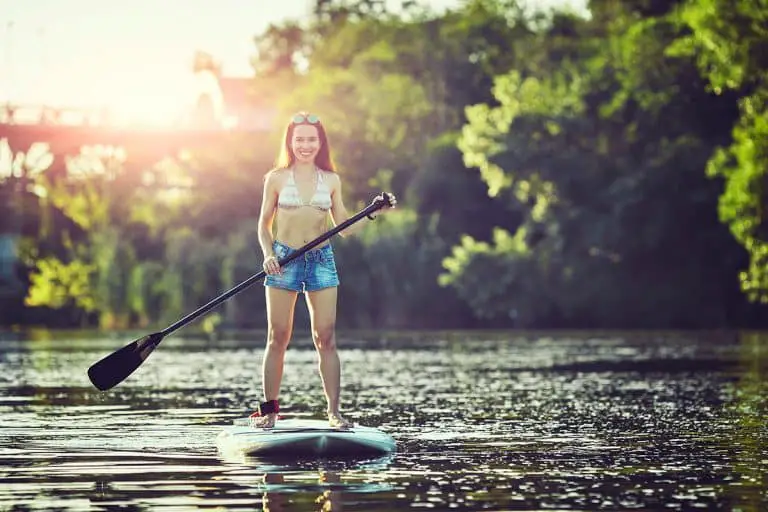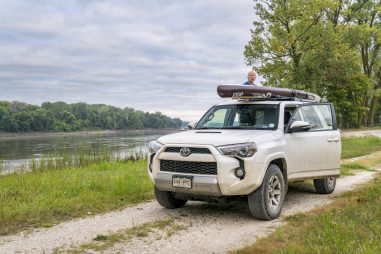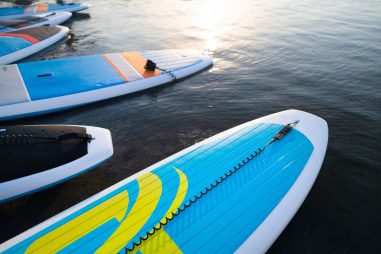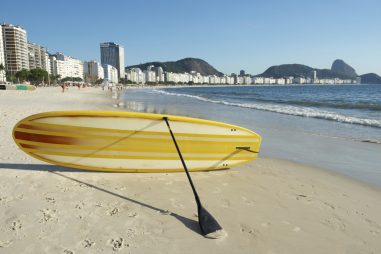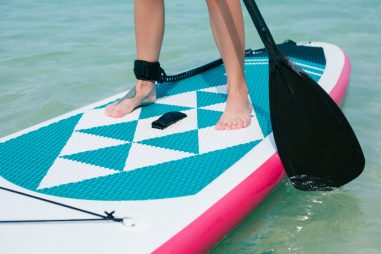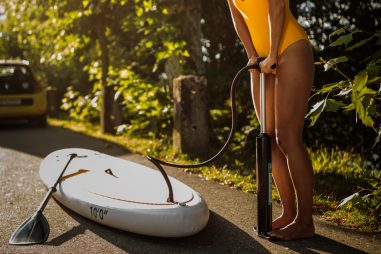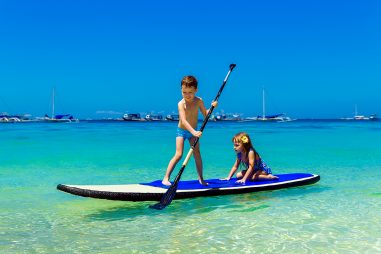Stand up paddle boarding has been around since time immemorial, but it wasn’t until the early 2000s that it became such a hit sport. Suddenly, the number of paddlers all over the world increased by millions. Today, it is on its way to being recognized in the Olympics, and when that happens, there will be no doubt that the ever-growing population of paddlers all over the world will continue to increase in the future.
What Is the Point of Stand Up Paddle Boarding?
The fundamentals of stand up paddle boarding are pretty straightforward—you get a board (which looks like a bigger version of a regular surfboard), you focus on your balance, and you stand upright on the board while you travel across the water using a paddle. It was supposed to be just another no-fuss water activity, but over the years, it has attracted many people all over the world for all the great things that stand up paddle boarding offers.
Stand up paddle boarding has evolved into something much more than a water activity. It gives you the opportunity to experience the water in a fun way that not only benefits your whole body but is also great for the mind. Stand up paddle boarding strengthens your core and builds your muscles, improves your balance and focus, and is a great way to meditate and reach a flow state of mind.
What Is a Stand Up Paddle Board Also Called?
Stand up paddle board is also popularly called as SUP. Nope, it’s not another cool way to say what’s up. SUP is a witty acronym for the sport that people came up with.
SUP had come a long way from when it was first recognized as a water activity. Now, everyone, regardless of age, gender, and fitness level, enjoys the sport.
Is Stand Up Paddle Boarding Fun?
Stand up paddle boarding is not only fun, but it is also A LOT of fun! It is something that you can either do alone or with your friend, family member or even your pet! It is such an inclusive activity that is not only enjoyable but is sure to get your muscles working and your heart pumping.
It offers another way for you to play and enjoy the water. Whether you do it in the sea, a lake, a reservoir, or a bay, paddling away on your board as you explore a new area is sure to be a fun experience
How Fast Is a Stand Up Paddle Board?
The speed of a stand up paddle board varies on how much power you put into paddling. But on average, a paddle board can go anything between 3 or 4 knots or approximately 3.5 to 4.5 miles per hour (mph) if you do a casual ride.
Some SUP racers reach the speed of 7 miles per hour or approximately 6 knots, but that’s not even the best of it. Professional stand up paddle board racers can even go at it at a whopping 17.7 miles per hour or 15.38 knots!
You can, of course, work on increasing your speed. As you get more experience paddling, your skill level will also increase, allowing you to paddle faster. Another factor that can affect your speed is physical fitness. If you work on your fitness, you can succeed in increasing your paddling speed.
There are also other factors that play a part in the speed of a paddler, such as board size, wind, and water conditions.
- Board Size: To find a significant increase in your paddling speed, you would need a board that is perfect for your height and weight. Smaller boards are said to be much faster than longer boards, but that is not always the case, especially if you are on the heavier side. If you are unsure of what size to get, it is always recommended to go to a sporting goods store specializing in stand up paddle boards to get expert advice.
- Wind: The wind is very dynamic, and depending on what direction it is blowing, it can be your friend or your foe. If you are riding along with the wind, it can guide you and even push your board to glide faster. On the other hand, you would have the most challenging time paddling if you go against the direction of the wind.
- Water conditions: If you want to break any speed records, then another thing that you should seriously consider is the state of the water in your location of choice. It is general knowledge that you would make significant progress in terms of your paddling speed if you ride in smooth and stable water as opposed to riding in rough and strong currents. But that is not to say that you would be the fastest paddler around if you ride in the placid water. On the contrary, locations like lakes or reservoirs where the water can be placid will test your physical fitness because your paddling speed in this environment depends on how fast you paddle.
Where Did Stand Up Paddle Boarding Originate?
It is not clear where stand up paddle boarding really originated but what’s evident is that people have been paddling as early as 3,000 BC, if not earlier. Natives of countries such as Peru, Israel, Italy, China, and Hawaii have been enjoying stand up paddle boarding in one form or another during these ancient times.
On the other hand, the roots of modern stand up paddle boarding can be traced all the way back to the shores of Hawaii in the 18th century. Hawaiians were the first ones to paddle along the Pacific, traveling from one island to another. At the time, their boards were made of wood and were described to be primitive, a stark contrast to the modern paddle boards that we have today.
Who Invented the Stand Up Paddle Board?
While the exact details of the history are a little shaky, it was said that all the way back in 3,000 BC in the city of Chan Chan in Peru, natives rode the waves as a form of sport and entertainment. Peruvian boards were called caballitos de totora, which translates to little horses made of reed. Tightly-bound reeds, which are tall, grass-like plants that are often found in swamps and wetlands, were the foundation of Peruvian paddle boards. To aid them in their ride was usually a stick of bamboo, which served as the paddle.
Israelis and Arabians had their own form of stand up paddle boarding that dated back to the 8th century AD. They used what was called a hasake which was described to be a hybrid between a board and a boat that was more commonly used for fishing. Hasake was designed to be 5-foot in width, which made it perfect for being a rescue vehicle for surfers, boatmen, and swimmers that ran into trouble while in the ocean.
In Italy in the 1400s, gondolas became a mode of transportation so Italians can move around the submerged cities. As what is evident today, the gondoliers stand on the deck of the gondolas, and they use an oar to control the boat as they move across the water.
The start of modern stand up paddle boarding can be attributed to a Waikiki surfer named John Ah Choy in the 1940s. Once a young and agile surfer, it soon became hard for Ah Choy to get up and down his board as he aged, so he resorted to standing on his board from the break and use a canoe paddle to catch the waves.
His technique was mimicked by Ah Choy’s sons, Leroy and Bobby, and their friend named Duke Kahanamoku which were famous surfing instructors in Hawaii and were collectively called as the Waikiki Beach Boys.
The Ah Choy brothers and Kahanamoku continued this style of riding until another monumental figure in the name of John Zapotocky came and carried on surfing the waves standing up until his death in 2013.
Is a Stand Up Paddle Board a Vessel?
The classification of stand up paddle board as a vessel varies from country to country. Here are some examples of the regulations being followed in the following countries.
- United States of America: The United States of America Coast Guard (USCG) officially classified stand up paddle boards as vessels. This means that paddlers have to comply with the Federal Navigation Rules set forth by USCG. These include wearing of personal flotation device or PFD whenever they are paddling in areas considered to be outside of the surf zone. To familiarize yourself with the rules and regulations, it is recommended to get in touch with your local Coast Guard offices.
- Canada: The classification depends on whether you are using the paddle board as a means to navigate or not. Transport Canada regarded navigation as either traveling from Point A to Point B or paddling across a body of water. So, if you intend to use a paddle board to do either, then you are required to carry mandatory safety equipment in compliance with the Small Vessel Regulations. But if you will be using the SUP to surf the waves or the beach, dock, or play at the waterfront, then you can enjoy your time without complying with any mandatory equipment requirements.
- United Kingdom: In the UK, stand up paddle boards are classified as either a recreational beach gear or a vessel, and they must be compliant with the UK maritime law. Your paddle board is considered to be a small sea vessel if it is hard and it is longer than 3.5 meters. If you are riding a vessel, you are allowed to travel up to two nautical miles away from sheltered shorelines, but you are required to wear a PFD, carry some form of towing device like ropes and light tracking device like a waterproof flashlight, and use a leash.
- Australia: The classification of stand up paddle board as a vessel or otherwise differs in the states in Australia. Here are the regulations in some of the states.
- New South Wales: In this state, stand up paddle boards are not classified as a vessel and are within the category of surfboards. Paddlers are not required to wear a lifejacket when paddling.
- Victoria: Stand up paddle boards are considered to be vessels in the state of Victoria. Categorized under Paddle Crafts, stand up paddle boards are included amongst other paddling activities such as canoeing, kayaking, row boating, and surf skiing. As such, paddlers are required to wear Type 1, 2, or 3 lifejackets at all times, especially if they are paddling more than 400 meters away from the shore.
- South Australia: In this Australian state, stand up paddle boards are considered to be recreational vessels. As such, paddlers are required to wear lifejackets when they are navigating on protected waters. However, there have been proposed mandatory equipment requirements for SUPs such as wearing of lifejackets when paddling more than 400 meters away from the shore of any semi-protected waters and compulsory wearing of lifejackets whenever aboard dragon boats.
- Western Australia: Unlike other paddle crafts like kayaks and canoes, stand up paddle boards are not considered to be a vessel in WA. The marine laws in this state do not apply to either surfboards or stand up paddle boards.
If you are unsure whether stand up paddle boards are classified as a vessel, or otherwise, it is recommended to get in touch with your national or local authorities to make sure that you are not violating any marine laws.
Is Stand Up Paddle Boarding a Sport?
Yes, stand up paddle boarding is considered to be a professional sport. Some people become so invested in the sport that they become professional paddlers who compete, instruct, and promote stand up paddle boarding.
If you are interested in going pro, you may want to check out the Professional Stand Up Paddle Association or PSUPA. It is a sports association that supports professional paddleboarders and instructors. They also promote safe, effective, and proper paddle boarding instruction so that people worldwide can safely pursue the sport.
Is Stand Up Paddle Boarding an Olympic Sport?
While stand up paddle board has yet to be competed on as an Olympic Sport at the moment, there has been significant progress on how the sport will be governed at the Olympic Level. In 2020, the Court of Arbitration for Sport (CAS) gave their landmark decision in favor of the International Surfing Association as the governing body of stand up paddle boarding at the Olympic Level.
In 2020, stand up paddle boarding was rumored to be included as one of the games in the 2024 Olympic Games to be held in Paris, France. However, stand up paddle boarding was not included in the final list of sports. Instead, enthusiasts and professional paddlers alike are awaiting the 2028 Olympics in hopes that stand up paddle boarding will have the Olympic recognition that it deserves.
Where Can I Stand Up Paddle Board in Los Angeles?
If you want to try to stand up paddle boarding to see what the buzz is about personally and you are around the Los Angeles area, hit up these paddle boarding hotspots to get the best stand up paddle boarding experience.
- Catalina Island: You would need to travel 22 miles off the coast of Southern California to get to Catalina Island, but this place is a sight to behold. Stand up paddlers will be greeted with coves and clear waters, and wildlife in the area includes dolphins, leopard sharks, California’s state marine fish, and golden orange garibaldis, among many other underwater lifeforms. If you came unprepared, you could rent out your stand up paddle board by the hour from DBOS. You would undoubtedly enjoy the island regardless of your skill level. While going to Catalina Island can be a lot of work (you can either travel by boat or helicopter), stand up paddle boarding in this location is sure to be one heck of an experience.
- Castaic Lake State Recreational Area: Offering 29 miles of just a perfectly majestic shoreline and two bodies of water, the Castaic Lake State Recreational Area is another fantastic spot to try stand up paddling boarding in if you are in the Los Angeles Area. You can either head out to the Lower Lake, where you would be in awe of the fantastic sights, or you can choose to paddle along the upper reservoir. This area, only 40 miles north of downtown LA, is the location of the 425-foot tall Castaic Dam, which is a popular paddling spot. Castaic Lake State Recreational Area offers paddling activities for people of all skill levels. You can also rent out paddle boards along with other water vehicles like kayaks and pedal-driven hydra bikes.
- Marina Del Ray Harbor: Boasting of eight protected canals for an amazing paddling experience, the Marina Del Ray Harbor is a stand up paddler’s dream vacation. The wildlife in the area includes a rich diversity of marine animals, including an abundance of leopard sharks. There are several stand up paddle board rental shops in the Marina Del Ray Harbor. You can choose from the Pro SUP Shop located in the Mother’s Beach, which offers SUP lessons and board rentals by the hour, and the Marina Del Ray Boat Rentals, which also offers amazing deals to stand up paddle boarding enthusiasts.
- Santa Cruz Island: Due to the many caves that can be explored via stand up paddle boarding, Stand Cruz Island is known to be the most popular SUP spot in all of Los Angeles. Paddlers can come and explore one of the largest sea caves in the world called Painted Cave. Whether you are a beginner or a professional paddler, there are a lot of tour companies that you can book your trip from. There are a lot of activities that you can do in the area, including swimming and snorkeling.
- Puddingstone Reservoir: Located in the Frank G. Bonelli Regional Park in San Dimas, Puddingstone Reservoir boasts a shoreline that stretches for five miles. This place is beginner-friendly and is great for paddlers of all skill levels. Wildlife in Puddingstone Reservoir includes over 250 species of birds, and a paddling trip here would sure to be a serene one since motorized boats are not allowed in the area. There are a lot of stand up paddle board rentals in Puddingstone Reservoir, including Wheel Fun Rentals, who rent out their board at 12 dollars per hour. If you don’t want to spend money on board rental, then you are welcome to bring your own but be guided that people in charge in the area will be inspecting your board before getting access to enter the water
- Pyramid Lake: Nestled in Castaic, Pyramid Lake is one of the best-kept secrets of the Angeles National Forest. While this place offers fantastic conditions for fishing and paddle boarding, it can get a little windy in the afternoon. Pyramid Lake boasts of several coves, four of which are located on the eastern side and are great for beginners.
- Huntington Harbor: The Huntington Harbor located in Huntington Beach is arguably the most beginner-friendly stand up paddle boarding location on the list. It offers water with smooth and subtle current, which is perfect for all the noobs. It’s great for yoga SUP as well as just chilling on your board. If you want to try something new and exciting, then head out to the northwest side of the harbor. There are a lot of companies offering guided tours around the area along with board rentals that start at 20 dollars for two hours. If you brought your own paddle board with you and you want to try launching it on your own, then head over to either Trinidad Island Park or Seabridge Park.
- Santa Monica State Beach: Located on the westside of Los Angeles, Santa Monica Beach is a popular location for all beach bums, and it is great for paddle boarding as well. The beach stretches for miles, and once you are on the water, you will have an unobstructed view of the whole shoreline of Malibu. A lot of paddle boarding schools offer SUP lessons, and there are also a lot of choices on board rentals. Of which, one of the most popular is Poseidon Paddle & Surf, which is located on Ocean Avenue.
- Latigo Beach: If you are looking for other spots in Malibu, then you can try Latigo Beach, which is only a few minutes away from central Malibu by car. Compared to other hangout areas in Malibu, Latigo Beach is pretty quiet, so you would have the most serene experience stand up paddle boarding. Once you are up on your board, you would be greeted by the fantastic Malibu shoreline along with the beachfront houses which populate the beach. Wildlife in this area includes seals and an abundance of marine animals. While there are no board rental shops directly located in the area, you can bring your own board, or you can book a board in advance and have it delivered to you by Radfish Malibu and other paddling companies near Latigo Beach.
- Topanga Beach: Topanga Beach is famous among stand up paddlers in the area and nearby cities. Even foreign paddlers come here to experience the challenges that Topanga Beach has for stand up paddlers. It offers two very different paddling experiences that you would think you are in two different locations. You can choose to either paddle close to the shore where the waves can test your balancing skill, or you can set out and paddle into the sea to find calmer wave conditions that allow for a more relaxed and leisurely ride.

